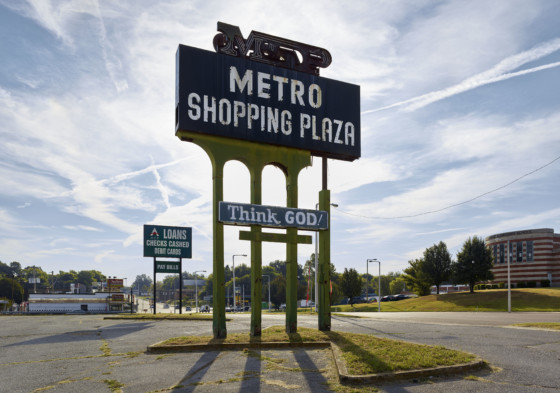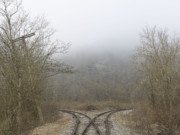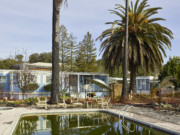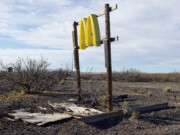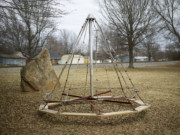Mark Power: Good Morning, America
Mark Power’s new book explores the landscapes of the United States from the perspective of a British photographer raised on American cultural exports
In a short afterword to his new photobook Good Morning, America (Volume One), Mark Power writes about his lifelong relationship with the country, which began well before he would travel there himself. “For as long as I can remember I’ve wanted to explore America, an ambition fueled by a legion of TV shows that crossed the Atlantic in the 1960s,” he writes. “As a young and impressionable child I devoured The Man from U.N.C.L.E. and The Fugitive, but it was the westerns, evoking a landscape altogether removed from the congested English suburbs surrounding me, that I loved most: Bonanza, High Chaparral, The Virginian and in particular Casey Jones, the adventures of a middle-aged railroad driver putting the world to rights.”
His dream became a reality when Power began to travel and photograph the country as part of the Magnum project Postcards from America, a group of photographers working collaboratively and finding innovative ways of disseminating their work. “I began – although I may not have realized it at the time – to search for the America which lived in my imagination, the one generated during childhood, the one that had probably never existed at all.”
Here, in his own words, Mark Power explains how an idea rooted in his formative years, which was encouraged by Postcards from America, has developed into this ongoing and in-depth exploration.
“My work in the U.S. has evolved, inevitably, over time, especially since Postcards came to an end in 2015. I never begin a project with a thesis I want to prove; if I did that I’d surely limit myself, denying myself all sorts of opportunities. I try to remain open-minded and, certainly, the longer I spend in America the more I learn… but the more confused I get as well. It’s such a complicated country, beset with problems, many running so deep it would be far too simplistic to blame them all solely on Trump.
“I’m a foreigner in America and I never forget that. In fact, I’m never allowed to forget it; being British makes me something of a mini-celebrity in every small town I visit. ‘Why’, I’m asked again and again, ‘of all the places I could go, am I here?’ That said, my English accent has often come in handy; it’s got me access to places I might otherwise have struggled to reach and it’s kept me safe (so far) when things have looked a little dicey, as they have on a few occasions.
"I keep a physical and metaphorical distance between myself and the subject."
- Mark Power
"I’m seeing America through the filter of an imposing cultural legacy that helped define me"
- Mark Power
“I keep a physical and metaphorical distance between myself and the subject. It’s a way of delineating my ‘foreignness’ and is a similar stance to the one I took while working in Poland making The Sound of Two Songs (2004-09). It’s comes very naturally to me; I’ve always felt I’m better at observing than participating, so to stand back and watch from afar suits me very well. It’s so different from working at home, in the UK, where I have a deeper understanding of why things are as they are. But, on balance, I quite like being from somewhere else. Remember, I’m seeing America through the filter of an imposing cultural legacy that helped define me. As such, it’s a strange mix of the familiar and unfamiliar, of fact and of fiction.
“I was involved in education for 25 years so I think I have a decent understanding of the history of photography in America. My tastes are eclectic, from Timothy O’Sullivan through to Onorato and Krebs, and I carry this legacy with me. I’ve lost count of the number of times I’ve looked at my ground glass screen and thought ‘that looks like a Baltz, or Eggleston, or Evans, Friedlander, Shore, Soth, Sternfeld etc.’ so I’ve taken to openly referencing this great history. I can’t pretend it isn’t there.
“I wouldn’t say I’m doing anything particularly new or innovative, but I’m not worried about that. Naturally I hope the work, when complete, will one day be seen as an important comment on America now, but only time will tell. Perhaps one marginally original (or foolhardy) idea is to publish the pictures across five volumes as ‘work in progress’. Another, I guess, is the equipment I use. I don’t like to get too technical, but my camera gear is a fundamental part of my process and I’m unrepentantly nerdy about perfection. Blame my Dad, who was an engineer.
“I use an Alpa Max technical camera with a Phase One back. I have only two lenses (a standard and a slightly wide) but the camera is extremely versatile, so this isn’t really a problem. The Alpa allows me, when appropriate, to slide the digital back left and right without moving either camera or tripod (all of Good Morning, America is made using a tripod). Because the perspective doesn’t alter, this technique produces two images that merge seamlessly together, giving a wider view but without distortion. The results are extremely detailed – far more than the human eye can see – a useful tool for someone who likes to stand back and observe. It took me a while to find a digital equivalent to the trusty 5×4 I used for 20 years, but this is it, and more besides.
"When outside the big cities, anyone visiting the States from the congestion of Europe can’t help but notice the enormity of the space, and the layers of history that are inevitably produced when a country is so big it’s not necessary to knock a building down in order to build another."
- Mark Power
“David Chandler wrote about my approach for The Financial Times Magazine, where he described how it speaks to my ‘sense of intimate distance because, as the enlarged scale and breadth can be achieved relatively close to his subject without distortion, the final image combines to give an impression that the photographer is at once detached and dispassionate but also in touch.’ He went on to describe how, as a fitting response to American space and culture, the cinematic appearance of the photographs echo a ‘widescreen experience’ and that ‘what we are looking at is already a representation; that uncanny sense of America as an image of itself.’
“That reference to space is fundamental to my fascination for America. When outside the big cities, anyone visiting the States from the congestion of Europe can’t help but notice the enormity of the space, and the layers of history that are inevitably produced when a country is so big it’s not necessary to knock a building down in order to build another.
“I’m writing this from North Dakota, where the winter has come early, and where town after town has a main street wider than London’s Piccadilly. It takes me right back to the westerns of my childhood. I work on foot, with tripod and camera slung over my shoulder, trudging around for hours everyday. From experience I’ve realized that pictures of places glimpsed from a passing car are rarely successful; they tend to be overt, and too much about the thing itself. On foot one notices the subtle nuances, how a space alters from step to step. My pictures from this particular trip are extremely quiet, some might say boring, and certainly wouldn’t be to everyone’s taste. But I’m trying to portray the monotony of these places, which are neither exciting nor dramatic; why, therefore, should I try to portray them as such? This strategy continues throughout all the work; I don’t believe that a picture of a demonstration, or a riot, is the only way of talking about economic or racial inequality. It’s manifest everywhere in the landscape. You just need to look for it.
David Chandler wrote that the work is a ‘grand sweep of American time and space’ across diverse environments and experience. But, most emphatically, it is a portrait of a ‘post-industrial culture still in the throes of convulsive change; a society where the signs of extreme inequality and degradation are now so commonplace that all across the country America seems not only to be falling into ruin, but falling back in time.‘
“I’m continuing to work in America, fingers and toes all crossed, for at least another four years, so the separate volumes can be neither thematic or geographic. I’m trying to juggle several subjects all at once; I believe this the right approach given the vastness and complexity of America. There is no text, yet, apart from captions and dates, but the current plan is that Volume Five, the final book, will contain a number of essays contextualizing the work.”
Signed copies of Good Morning, America (Volume IV), the latest in the series, are available on the Magnum Shop here.



















